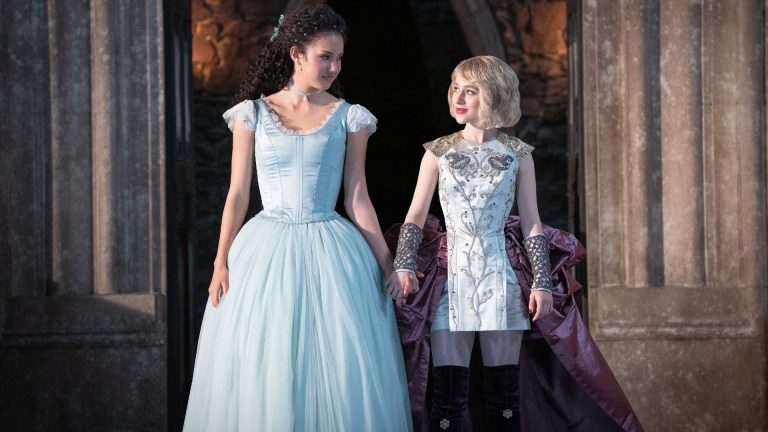The School for Good and Evil Ending Explained: How It Sets Up Part 2
What “true love’s kiss” means in Netflix’s YA fantasy movie, and whether there will be a sequel.

The School for Good and Evil, Paul Feig’s fantasy adventure film based on Soman Chainani’s YA book series, explores the gray areas in fairy tale morality through a pair of girls who are whisked away to the titular Schools for Good and Evil (SGE for short). Sophie (Sophia Anne Caruso), who has always considered herself something of an unappreciated Cinderella within the town of Gavaldon, longs to be the kind of princess she’s only read about in fairy tales. Agatha (Sofia Wylie), regarded as the town witch, only wants Sophie to be happy.
When Sophie writes to the SGE begging for enrollment, she and Agatha are transported there… but then Sophie gets dropped into the School for Evil, while Agatha wakes up at the School for Good. With the School Master Rhian (Laurence Fishburne) staunchly claiming that there are no mistakes at his school, each girl must try to conform to an unfamiliar and uncomfortable environment (Aggie taming her hair and practicing smiles, Sophie shrieking at putrid boils and fearsome familiars). It doesn’t help that their respective professors Dovey (Kerry Washington) and Lesso (Charlize Theron) are just waiting for them to flunk out.
Confronting the School Master only leads the girls to the Storian, a sentient quill (voiced by Cate Blanchett) that is in the middle of writing their narrative. Their only way out of this story is to discover “true love’s kiss,” which Sophie believes to lie in Tedros (Jamie Flatters), the son of King Arthur. But even as Sophie tries to find her way over to the Good school, and Agatha just tries to get home, each also finds herself tapping into surprising powers: Aggie can heal those who were transformed by curses, and Sophie can make people actually respect and fear her. (It helps that the School Master’s dead brother Rafal (Kit Young) has taken an interest in her and wants to pass on his blood magic.)
And then all hell breaks out in the battle of Good versus Evil. Here’s everything that went down at the end of The School for Good and Evil and what it might mean for a sequel…
Fairy Tale Nemesis: Sophie vs. Agatha
From the moment that Professor Lesso tells the Nevers that their story does not begin until they have found a Nemesis, it was clear that it was only a matter of time before the two best friends would be turned against one another. Despite Sophie’s insistence that she’s Good, it doesn’t take long for her to decide that Agatha must be sabotaging her chances within the SGE.
Lesso helps things along by cutting off Sophie’s treasured hair, though that only aids her in leaning into a bitchy, fledgling evil persona. What cements it is Sophie’s failure in the Trial by Tale with Tedros, which is meant to determine whether a Never and an Ever can actually date. Though Agatha tries to use her magic to help Sophie win the Trial (and therefore admittance to the Ever Ball, where she will try for that true love’s kiss), it’s Sophie’s rigid adherence to fairy tale tropes that ruins the test: Instead of using Excalibur to save Tedros—because she reasons the prince is supposed to rescue the princess, not the other way around—Sophie lets him almost get killed.
It’s Agatha who picks up the sword and saves Tedros’ life, but in doing so reveals that she helped Sophie cheat in the first place. That only creates a domino effect in which Rafal appears to Sophie and offers her blood magic, which transforms her into a hag witch but also allows her to manipulate the reality of SGE itself.
Good and Evil Reversed
After years of the Evers having all the fun, the Evil students establish the first-ever Nevers Ball, where they get to dance like a bunch of normal teenagers. But after Sophie crashes the Ever Ball in her witch persona, she leads Tedros and the Evers over to the School for Evil. When the young prince and his peers attack the Nevers unprovoked, Sophie uses the School for Good’s rules against them: If Evil attacks and Good defends, then surely the Nevers must be the ones who are Good.
She transforms them, Disney-movie-style, into glittering white/silver gowns and good hygiene… which in turn makes the Evers into the Evil ones, complete with black wardrobe and plenty of scars and warts to bring out their inner ugliness.
The School Master and the Storian
But the true villains are not the adolescents caught up in the stories they’ve been force-fed, but the ones sharing those stories. Agatha, Sophie, and Tedros confront the School Master, who is revealed not to be Good brother Rhian, but Evil brother Rafal in disguise all along.
Even though Agatha reiterates the point that Good has won the yearly battle between the Schools for over 200 years, it turns out that that was by design, too. Part of Rafal’s nefarious plan was to corrupt fairy tales themselves, inspiring the supposedly “Good” protagonists to resort to darker and more wicked means to dispose of their nemeses: cooking them in ovens, throwing them off cliffs, the like. Or even the more subtle matters that Agatha witnessed in her studies, like prizing beauty (vanity) and Goodness (arrogance) above all. Sophie was right.
Rafal’s Never After
Disillusioned and (she thinks) alone, Sophie is seduced by Rafal claiming that he’s the only one who understands her, and she accepts his offer to rule “Never After” by his side, which they seal with true love’s kiss. But what happens instead is that their dark union transforms the SGE into a netherworld, which requires the sacrifice of all of the students, Evil and Good—Sophie’s newfound friends among the Nevers, and Tedros, and Agatha. Sophie immediately regrets giving Rafal the power to create Never After, but it’s too late.
…Until, that is, the final battle in which Rafal tries to kill Agatha with the Storian quill, which is (of course) also an arrow. Sophie jumps in front of her best friend, taking the arrow meant for her, which undoes Rafal’s spell; it needed a dark queen who was alive, a testament to Sophie’s burgeoning powers. The last spell she does with her finger is to help nudge Excalibur over to Agatha, who uses it to slay Rafal.
Never After, already crumbling with Sophie’s fading life, is restored back to the SGE, reversing the flow of time so that everyone is saved. Except, of course, the princess/witch who offered up her life.
True Love’s Kiss
Despite the narrative setting up a seeming love triangle among Sophie, Agatha, and Tedros, things go a similar route to Disney’s Frozen (interestingly, the movie and the first SGE book both came out in 2013) in defining what is truly true love. As Sophie lies bleeding out in Agatha’s arms, they apologize to one another and reiterate that being together was more important than magic or changing the world. As Sophie struggles to say with her dying words that she didn’t want to be Evil, Agatha reassures her: “You are not Evil, you’re just human.”
Aggie kisses her best friend goodbye, which saves Sophie’s life—just like the love between sisters Anna and Elsa, this bond supersedes any storybook prince or glittery romance. Sophie comes back to life, shocking both of them but fulfilling the Storian’s proclamation.
And while Agatha also smooches Tedros, it’s a goodbye: Rather than stay on at the School for Good, she wants to return to Gavaldon with Sophie.
Will There Be a Sequel?
That said, the movie ends on a requisite cliffhanger: Just as the girls are settling back into their old roles in Gavaldon (albeit with some magic to use on their shitty peers), Tedros’ arrow flies through a vortex to strike the Wishing Tree. “Agatha, I need you,” his voice echoes—and then a blade with an animal-shaped hilt splits the arrow, implying that the danger is close behind.
While Netflix has not yet announced a sequel, there is more than enough material to make not just another movie, but a series of them: Chainani has written six SGE books, with the last installment published in 2020.
The second novel, A World Without Princes, involves the two Schools separated not by morality but by gender; teases Agatha and Tedros’ distrust of Sophie, with the fear that she will give back in to her evil witchy ways; and even has one of the girls go undercover as a boy to infiltrate the new institution.
Future books have such enticing titles as The Last Ever After and The One True King, with prevailing themes including the constant transformation of the two Schools based on whichever two elements are currently in conflict; Agatha and Tedros’ ongoing romance, as well as the fate of Camelot; and Sophie’s struggles with what it actually means to be Good… and whether Evil itself can be reformed.
And while we wait to find out Sophie and Agatha’s cinematic fates, you can go back to the source: Chainani has written a prequel duology about the twin School Masters, with Rise of the School of Good and Evil published in 2022 and Fall of the School for Good and Evil coming May 2, 2023.
The School for Good and Evil is streaming on Netflix.
